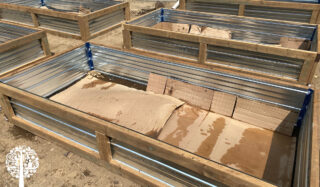Here’s The Dirt: Hugelkultur In Raised Garden Beds
Gardening in raised beds offers many perks, like warmer soil and fewer weeds. They’re also easier on the back and an excellent solution if the earth around your home is compacted. But filling them can be expensive! We recently built eight raised beds at our new house, and I helped bring down the cost using hugelkultur and a homemade soil blend!

Hugelkultur: So Many Benefits
Hugelkultur in raised beds? Hell, yeah! Why not?
Hugelkultur is an ancient, no-dig technique that involves building soil with woody debris and other natural materials from around the forest or your yard. Think logs, branches, and fallen leaves.
This method is economical and helps clean up your outdoor space, but the best part is that it sequesters carbon and eventually leads to fertile soil bursting with microbial life that doesn’t require much watering. Who doesn’t love a climate-friendly way to grow plants?
Finding Logs
I have a large property, so sourcing logs wasn’t an issue. There is plenty of hardwood lying on our forest floor, giving me a jumpstart on the decomposition process.

Many of the trunks I found for this project are covered in mushrooms and webs of mycelium! I also spotted more than a few earthworms wiggling inside, which can only lead to good things (like amazing harvests).
Filling The Beds
My raised beds are 8’x’4 and 20” deep. I put cardboard down to suppress weeds and encourage earthworms to find their way into the beds.
I filled the bottom foot with logs and branches, watered them, and put a layer of decomposed leaves on top. I watered again and then continued with a homemade soil blend I found in Joe Lamp’l’s book, The Vegetable Gardening Book (an incredible read for new and seasoned gardeners alike).
Joe says his perfect raised bed soil recipe leads to healthier veggies and excellent yields.
Joe Lamp’l’s Raised Bed Soil Recipe
- 50% high-quality topsoil
- 30% high-quality compost
- 20% organic matter
I purchased the topsoil and compost in bulk, which is always more affordable than buying bags, especially when you have more than one bed to fill.
As for the 20% organic matter, I used leaves, sheep manure, kitchen scraps, and a mineralized soil blend. I add worm castings for good measure as I plant.
The soil in my raised beds is fluffy and rich; it’s just the right texture. I’ll have some of this on standby as the logs break down this summer and throughout the off-season, resulting in a dip in soil levels.
I can’t wait to see how my hugelkultur beds will work out in future growing seasons. Stay tuned!




